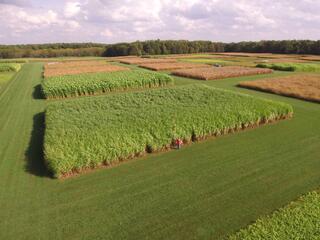Synthesized biorefinery highlights potential cost savings for cellulosic biorefinery

Background/Objective
The use of lignocellulosic biomass as a feedstock for isobutanol (IBA) has sustainability benefits, but the biological conversion to IBA faces challenges, such as low yields and byproduct formation.
Approach
Researchers demonstrated high-yield IBA production from poplar, sorghum, and switchgrass pretreated with a γ-valerolactone (GVL)-based process. They developed a biorefinery where bioenergy crops are pretreated and hydrolysed, and IBA is removed with vacuum flash to avoid toxic IBA concentrations. Using a process optimization model, they performed technoeconomic and sensitivity analyses to estimate production costs and identify potential improvements.
Results
Based on experimental results using the BTX1858 strain of Saccharomyces cerevisiae, which consumed most available glucose and produced IBA at 89-94% theoretical yields, the synthesized biorefinery could produce IBA at a minimum fuel selling price (MFSP) of $14.40-$16.01 per gasoline gallon equivalent, with sorghum resulting in the lowest price. Solvent/biomass ratio during pretreatment and enzyme loading during hydrolysis have the greatest impact on MFSP; improvements in these parameters can reduce the MFSP by up to 46%.
Impact
Isobutanol produced from dedicated energy crops is a promising sustainable biofuel with advantages over ethanol: it holds more energy, is less corrosive, doesn’t evaporate as fast when blended with gasoline, and can be upgraded into other products like jet fuel. This study identifies parameters for future studies aimed at reducing biorefinery production costs.